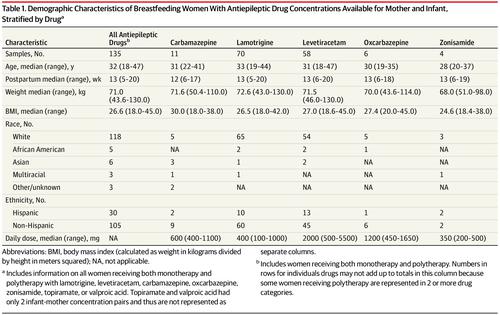当前位置:
X-MOL 学术
›
JAMA Neurol.
›
论文详情
Our official English website, www.x-mol.net, welcomes your
feedback! (Note: you will need to create a separate account there.)
Antiepileptic Drug Exposure in Infants of Breastfeeding Mothers With Epilepsy.
JAMA Neurology ( IF 20.4 ) Pub Date : 2020-04-01 , DOI: 10.1001/jamaneurol.2019.4443 Angela K Birnbaum 1 , Kimford J Meador 2 , Ashwin Karanam 1 , Carrie Brown 3 , Ryan C May 3 , Elizabeth E Gerard 4 , Evan R Gedzelman 5 , Patricia E Penovich 6 , Laura A Kalayjian 7 , Jennifer Cavitt 8 , Alison M Pack 9 , John W Miller 10, 11 , Zachary N Stowe 12 , Page B Pennell 13 ,
JAMA Neurology ( IF 20.4 ) Pub Date : 2020-04-01 , DOI: 10.1001/jamaneurol.2019.4443 Angela K Birnbaum 1 , Kimford J Meador 2 , Ashwin Karanam 1 , Carrie Brown 3 , Ryan C May 3 , Elizabeth E Gerard 4 , Evan R Gedzelman 5 , Patricia E Penovich 6 , Laura A Kalayjian 7 , Jennifer Cavitt 8 , Alison M Pack 9 , John W Miller 10, 11 , Zachary N Stowe 12 , Page B Pennell 13 ,
Affiliation

|
Importance
There is limited information on infant drug exposure via breastfeeding by mothers who are receiving antiepileptic drug therapy.
Objective
To provide direct, objective information on antiepileptic drug exposure through breast milk.
Design, Setting, and Participants
This prospective cohort study was conducted between December 2012 to October 2016, with follow-up in children until 6 years of age at 20 sites across the United States. Data were collected via an observational multicenter investigation (Maternal Outcomes and Neurodevelopmental Effects of Antiepileptic Drugs [MONEAD]) of outcomes in pregnant mothers with epilepsy and their children. Pregnant women with epilepsy who were aged 14 to 45 years, had pregnancies that had progressed to less than 20 weeks' gestational age, and had measured IQ scores of more than 70 points were enrolled and followed up through pregnancy and 9 postpartum months. Their infants were enrolled at birth. Data were analyzed from May 2014 to August 2019.
Exposures
Antiepileptic drug exposure in infants who were breastfed.
Main Outcomes and Measures
The percentage of infant-to-mother concentration of antiepileptic drugs. Antiepileptic drug concentrations were quantified from blood samples collected from infants and mothers at the same visit, 5 to 20 weeks after birth. Concentrations of antiepileptic drugs in infants at less than the lower limit of quantification were assessed as half of the lower limit. Additional measures collected were the total duration of all daily breastfeeding sessions and/or the volume of pumped breast milk ingested from a bottle.
Results
A total of 351 women (of 865 screened and 503 eligible individuals) were enrolled, along with their 345 infants (179 female children [51.9%]; median [range] age, 13 [5-20] weeks). Of the 345 infants, 222 (64.3%) were breastfed; the data collection yielded 164 matching infant-mother concentration pairs from 138 infants. Approximately 49% of all antiepileptic drug concentrations in nursing infants were less than the lower limit of quantification. The median percentage of infant-to-mother concentration for all 7 antiepileptic drugs and 1 metabolite (carbamazepine, carbamazepine-10,11-epoxide, levetiracetam, lamotrigine, oxcarbazepine, topiramate, valproate, and zonisamide) ranged from 0.3% (range, 0.2%-0.9%) to 44.2% (range, 35.2%-125.3%). In multiple linear regression models, maternal concentration was a significant factor associated with lamotrigine concentration in infants (Pearson correlation coefficient, 0.58; P < .001) but not levetiracetam concentration in infants.
Conclusions and Relevance
Overall, antiepileptic drug concentrations in blood samples of infants who were breastfed were substantially lower than maternal blood concentrations. Given the well-known benefits of breastfeeding and the prior studies demonstrating no ill effects when the mother was receiving antiepileptic drugs, these findings support the breastfeeding of infants by mothers with epilepsy who are taking antiepileptic drug therapy.
中文翻译:

患有癫痫症的母乳喂养婴儿的抗癫痫药暴露。
重要性关于接受抗癫痫药物治疗的母亲通过母乳喂养接触婴儿药物的信息很少。目的提供有关通过母乳暴露的抗癫痫药物的直接,客观的信息。设计,环境和参与者这项前瞻性队列研究于2012年12月至2016年10月进行,在美国20个地点对6岁以下的儿童进行了随访。通过观察性多中心调查(抗癫痫药的母亲预后和神经发育作用[MONEAD])收集了癫痫孕妇及其孩子的结局数据。患有癫痫病的孕妇年龄在14至45岁之间,怀孕已发展到小于20周的胎龄,并测得智商得分超过70分,并在妊娠和产后9个月进行随访。他们的婴儿在出生时就入学了。分析了2014年5月至2019年8月的数据。暴露母乳喂养的婴儿的抗癫痫药暴露。主要结果和措施婴儿对母亲的抗癫痫药浓度的百分比。从出生后5至20周的同一次访问中,从婴儿和母亲的血液样本中量化抗癫痫药的浓度。婴儿中抗癫痫药的浓度低于定量下限,被评估为下限的一半。收集的其他指标是所有每日母乳喂养时间的总持续时间和/或从奶瓶中摄入的抽乳量。结果总共招募了351名妇女(有865名筛查者和503名合格者),以及其345名婴儿(179名女儿童[51.9%];中位年龄[13] [5-20]周)。在345名婴儿中,有222名(64.3%)为母乳喂养;数据收集产生了来自138个婴儿的164个匹配的母婴浓度对。护理婴儿中所有抗癫痫药浓度的约49%低于定量下限。所有7种抗癫痫药和1种代谢物(卡马西平,卡马西平10,11-环氧化物,左乙拉西坦,拉莫三嗪,奥卡西平,托吡酯,丙戊酸盐和唑尼沙胺)的婴儿至母亲浓度中值百分比范围为0.3%(范围为0.2) %-0.9%)到44.2%(范围35.2%-125.3%)。在多个线性回归模型中 母体浓度是与婴儿中拉莫三嗪浓度相关的重要因素(皮尔森相关系数为0.58; P <.001),但与婴儿左乙拉西坦浓度无关。结论和相关性总体而言,母乳喂养婴儿的血液样本中抗癫痫药的浓度大大低于母体血药浓度。鉴于母乳喂养的众所周知的好处,并且先前的研究表明母亲服用抗癫痫药物时没有不良反应,这些发现支持了正在接受抗癫痫药物治疗的癫痫母亲对婴儿的母乳喂养。母乳喂养婴儿的血液样本中抗癫痫药的浓度大大低于母体血药浓度。鉴于母乳喂养的众所周知的好处,并且先前的研究表明母亲服用抗癫痫药物时没有不良反应,这些发现支持了正在接受抗癫痫药物治疗的癫痫母亲对婴儿的母乳喂养。母乳喂养婴儿的血液样本中的抗癫痫药浓度大大低于母体血药浓度。鉴于母乳喂养的众所周知的好处,并且先前的研究表明母亲服用抗癫痫药物时没有不良反应,这些发现支持了正在接受抗癫痫药物治疗的癫痫母亲对婴儿的母乳喂养。
更新日期:2020-04-01
中文翻译:

患有癫痫症的母乳喂养婴儿的抗癫痫药暴露。
重要性关于接受抗癫痫药物治疗的母亲通过母乳喂养接触婴儿药物的信息很少。目的提供有关通过母乳暴露的抗癫痫药物的直接,客观的信息。设计,环境和参与者这项前瞻性队列研究于2012年12月至2016年10月进行,在美国20个地点对6岁以下的儿童进行了随访。通过观察性多中心调查(抗癫痫药的母亲预后和神经发育作用[MONEAD])收集了癫痫孕妇及其孩子的结局数据。患有癫痫病的孕妇年龄在14至45岁之间,怀孕已发展到小于20周的胎龄,并测得智商得分超过70分,并在妊娠和产后9个月进行随访。他们的婴儿在出生时就入学了。分析了2014年5月至2019年8月的数据。暴露母乳喂养的婴儿的抗癫痫药暴露。主要结果和措施婴儿对母亲的抗癫痫药浓度的百分比。从出生后5至20周的同一次访问中,从婴儿和母亲的血液样本中量化抗癫痫药的浓度。婴儿中抗癫痫药的浓度低于定量下限,被评估为下限的一半。收集的其他指标是所有每日母乳喂养时间的总持续时间和/或从奶瓶中摄入的抽乳量。结果总共招募了351名妇女(有865名筛查者和503名合格者),以及其345名婴儿(179名女儿童[51.9%];中位年龄[13] [5-20]周)。在345名婴儿中,有222名(64.3%)为母乳喂养;数据收集产生了来自138个婴儿的164个匹配的母婴浓度对。护理婴儿中所有抗癫痫药浓度的约49%低于定量下限。所有7种抗癫痫药和1种代谢物(卡马西平,卡马西平10,11-环氧化物,左乙拉西坦,拉莫三嗪,奥卡西平,托吡酯,丙戊酸盐和唑尼沙胺)的婴儿至母亲浓度中值百分比范围为0.3%(范围为0.2) %-0.9%)到44.2%(范围35.2%-125.3%)。在多个线性回归模型中 母体浓度是与婴儿中拉莫三嗪浓度相关的重要因素(皮尔森相关系数为0.58; P <.001),但与婴儿左乙拉西坦浓度无关。结论和相关性总体而言,母乳喂养婴儿的血液样本中抗癫痫药的浓度大大低于母体血药浓度。鉴于母乳喂养的众所周知的好处,并且先前的研究表明母亲服用抗癫痫药物时没有不良反应,这些发现支持了正在接受抗癫痫药物治疗的癫痫母亲对婴儿的母乳喂养。母乳喂养婴儿的血液样本中抗癫痫药的浓度大大低于母体血药浓度。鉴于母乳喂养的众所周知的好处,并且先前的研究表明母亲服用抗癫痫药物时没有不良反应,这些发现支持了正在接受抗癫痫药物治疗的癫痫母亲对婴儿的母乳喂养。母乳喂养婴儿的血液样本中的抗癫痫药浓度大大低于母体血药浓度。鉴于母乳喂养的众所周知的好处,并且先前的研究表明母亲服用抗癫痫药物时没有不良反应,这些发现支持了正在接受抗癫痫药物治疗的癫痫母亲对婴儿的母乳喂养。











































 京公网安备 11010802027423号
京公网安备 11010802027423号